
A meteorite is a rock that originated in outer space and has fallen to the surface of a planet or moon. When the original object enters the atmosphere, various factors such as friction, pressure, and chemical interactions with the atmospheric gases cause it to heat up and radiate energy. It then becomes a meteor and forms a fireball, also known as a shooting star; astronomers call the brightest examples "bolides". Once it settles on the larger body's surface, the meteor becomes a meteorite. Meteorites vary greatly in size. For geologists, a bolide is a meteorite large enough to create an impact crater.
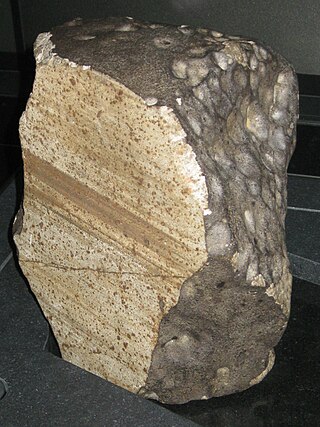
The Wold Cottage meteorite fell near Wold Cottage farm in 1795, a few miles away from the village of Wold Newton in Yorkshire, England.

In southeastern Russia, an iron meteorite fell on the Sikhote-Alin Mountains in 1947. Large iron meteorite falls have been witnessed, and fragments have been recovered, but never before in recorded history has a fall of this magnitude occurred. An estimated 23 tonnes of fragments survived the fiery passage through the atmosphere and reached the Earth.

Mesosiderites are a class of stony–iron meteorites consisting of about equal parts of metallic nickel-iron and silicate. They are breccias with an irregular texture; silicates and metal occur often in lumps or pebbles as well as in fine-grained intergrowths. The silicate part contains olivine, pyroxenes, and Ca-rich feldspar and is similar in composition to eucrites and diogenites.

A meteorite fall, also called an observed fall, is a meteorite collected after its fall from outer space was observed by people or automated devices. Any other meteorite is called a "find". There are more than 1,300 documented falls listed in widely used databases, most of which have specimens in modern collections. As of February 2023, the Meteoritical Bulletin Database had 1372 confirmed falls.
Meteorite fall statistics are frequently used by planetary scientists to approximate the true flux of meteorites on Earth. Meteorite falls are those meteorites that are collected soon after being witnessed to fall, whereas meteorite finds are discovered at a later time. Although there are 30 times as much finds than falls, their raw distribution of types does not accurately reflect what falls to Earth. The reasons for this include the following:
The Carancas impact event refers to the fall of the Carancas chondritic meteorite on September 15, 2007, near the village of Carancas in Peru, close to the Bolivian border and Lake Titicaca. The impact created a small crater in the clay soil and scorched earth around its location. A local official, Marco Limache, said that "boiling water started coming out of the crater, and particles of rock and cinders were found nearby", as "fetid, noxious" gases spewed from the crater. Surface impact occurred above 3,800 metres (12,500 ft).
Mineo was one of the only four witnessed fall pallasite meteorites in the world, and the only one from Italy.
Total known weight (TKW), also total known mass, is a term used mainly by dealers and meteorite collectors to indicate the combined weight of all known pieces from a single named meteorite. The total known mass of a named meteorite is a fraction of the mass of the original meteoroid that entered Earth's atmosphere to produce the meteorite.

The Ensisheim meteorite is a stony meteorite that fell on November 7, 1492 in a wheat field outside the walled town of Ensisheim in then Alsace, Further Germany. The meteorite can still be seen in Ensisheim's museum, the sixteenth-century Musée de la Régence. It is the oldest stony European meteorite fall from which there is still some meteoritic material preserved.

Meteorite hunting is the search for meteorites. A person engaged in the search for meteorites is known as a meteorite hunter. Meteorite hunters may be amateurs who search on the weekends and after work, or professionals who recover meteorites for a living. Both frequently use tools such as metal detectors or magnets to discover the meteorites.
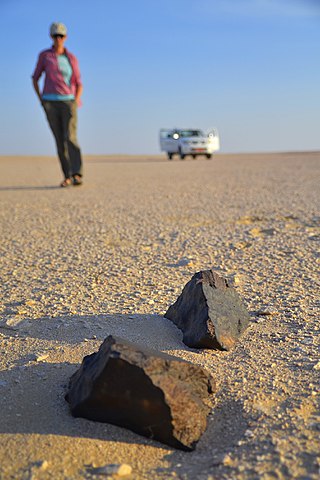
A meteorite find is a meteorite that was found by people, but whose fall was not observed. They may have been on Earth's surface for as many as thousands of years and therefore could have been subject to varying amounts of weathering.
St-Robert is an ordinary chondrite meteorite fell on Quebec on June 14, 1994.

The Weston meteorite is an H4 ordinary chondrite meteorite which fell to earth above the town of Weston, Connecticut on the morning of December 14, 1807.
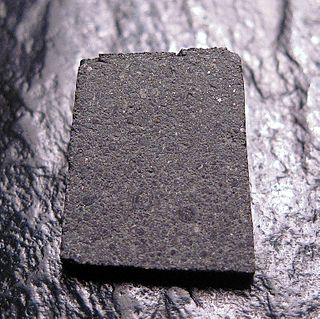
Moss is a carbonaceous chondrite meteorite that fell over the communities of Rygge and Moss in Østfold county, southeast southern Norway in the morning of midsummer day, July 14, 2006.

The Middlesbrough meteorite fell in Middlesbrough, North Yorkshire, England on 14 March 1881.
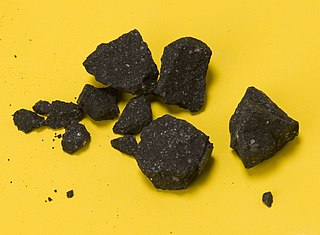
The Sutter's Mill meteorite is a carbonaceous chondrite which entered the Earth's atmosphere and broke up at about 07:51 Pacific Time on April 22, 2012, with fragments landing in the United States. The name comes from Sutter's Mill, a California Gold Rush site, near which some pieces were recovered. Meteor astronomer Peter Jenniskens assigned Sutter's Mill (SM) numbers to each meteorite, with the documented find location preserving information about where a given meteorite was located in the impacting meteoroid. As of May 2014, 79 fragments had been publicly documented with a find location. The largest (SM53) weighs 205 grams (7.2 oz), and the second largest (SM50) weighs 42 grams (1.5 oz).

The Novato meteorite is an ordinary chondrite which entered the Earth's atmosphere and broke up over Northern California at 19:44 Pacific Time on 17 October 2012. The falling bolide created a bright fireball and sonic booms and fragmented into smaller pieces as the intense friction of passing through the atmosphere heated it and absorbed its kinetic energy. The meteoroid was about 35 centimeters (14 in) across.
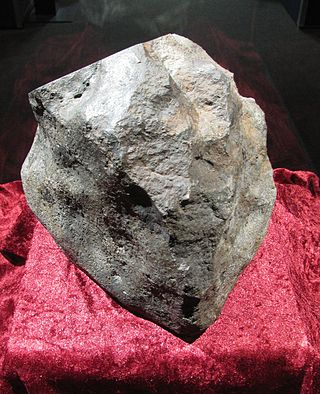
The Oldenburg meteorite fell 23 km from Oldenburg, Niedersachsen, Germany on 10 September 1930, one stone falling in Bissel, the other in Beverbruch. The mass of this meteorite is 16.57kg.
This is a glossary of terms used in meteoritics, the science of meteorites.














